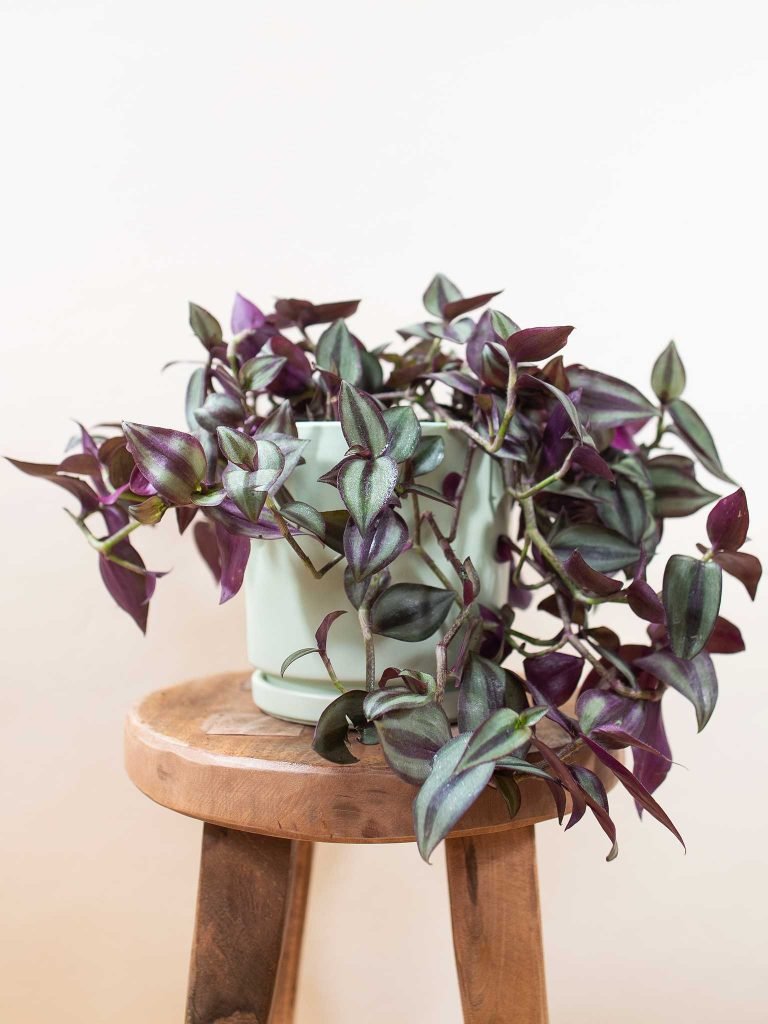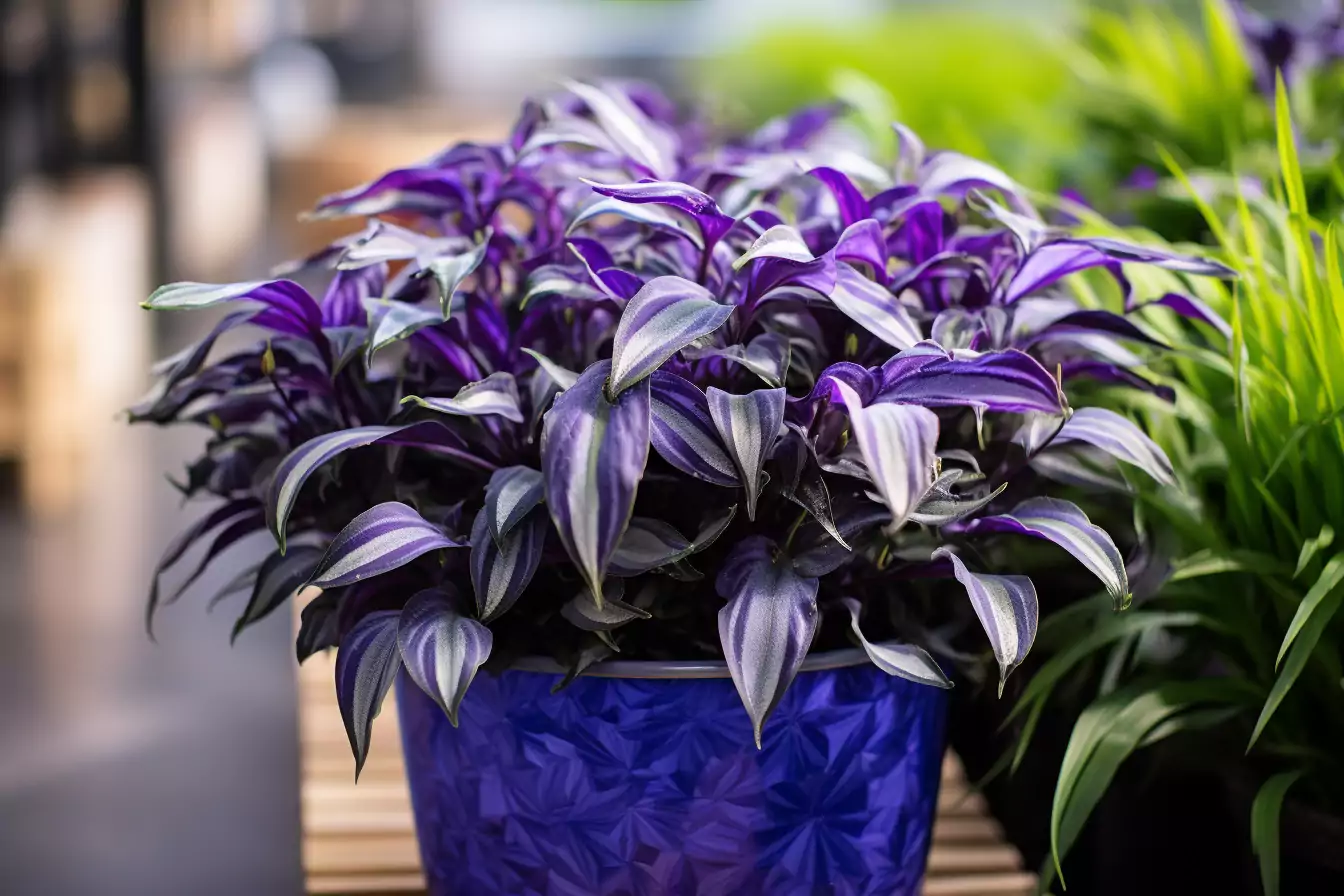Botanical Name: Tradescantia zebrina
Nicknames: Zebrina, Wandering Jew, Spiderwort, Inch Plant, Flowering Inch Plant, Purple Queen
The Zebrina plant has been a very popular houseplant for a lot longer than most other houseplants. The leaves are a zebra-like pattern comprised of shades of green, purple, and even silver. It can survive in nearly any environment and is a great plant for beginners because of how easy it is to care for. You’ll want to give it a spot in your home with more light as too dim will cause the plant to lose its variegation. It is the perfect natural air cleaner as the leaves help to remove harmful VOCs in the air and replace it with fresh, clean air.

Embracing the Light: The Zebrina’s Love for Brightness
The Zebrina, like a sunbathing beauty, thrives in bright, indirect light. It’s crucial to find that sweet spot where the light is just right – think of Goldilocks, but for plants! Place your Zebrina near a window where it can bask in the morning sun but is shielded from the harsh afternoon rays. This exposure ensures vibrant leaf colors and promotes healthy growth.
Tip: Rotate your plant periodically to ensure even growth on all sides.
Water Wonders: Quenching the Zebrina’s Thirst
Watering is like a delicate dance with the Zebrina. It prefers its soil to be consistently moist, but not waterlogged. I’ve found that the best approach is to check the top inch of the soil – if it’s dry, it’s time to water. This plant is quite forgiving, so don’t stress if you miss a watering or two.
Alert: Overwatering can lead to root rot, a common pitfall for many plant parents.
Creating the Perfect Environment: Humidity and Temperature
The Zebrina flourishes in a humid environment, reminiscent of its tropical origins. Maintaining a humidity level around 50% will make your plant feel right at home. If your indoor air is too dry, consider using a humidifier or placing a water tray near the plant.
When it comes to temperature, think warm and cozy. Zebrinas love temperatures between 65°F and 75°F (18°C to 24°C). Keep them away from drafts, air conditioners, and heating vents to prevent stress.
Tip: Grouping plants together can also help increase humidity levels.
Growth Goals: Achieving Lush, Full Plants
The growth of a Zebrina can be quite rapid, especially in favorable conditions. Its trailing vines can extend several feet, making it an ideal candidate for hanging baskets or high shelves. Regular pruning encourages bushier growth and keeps your plant looking tidy.
Alert: Leggy growth can be a sign of insufficient light. Adjust the plant’s location if necessary.
Time to Repot: Keeping Your Zebrina Happy
Repotting is an essential part of the Zebrina’s care routine. As a fast grower, it may need to be repotted annually. Choose a pot that’s slightly larger than the current one and ensure it has good drainage. Spring or early summer is the best time for repotting, as the plant is entering its active growth phase.
Tip: Use a well-draining potting mix to promote healthy root growth.
The Joy of Propagating: Sharing the Zebrina Love
Propagating a Zebrina is as easy as pie and incredibly rewarding. Simply snip a piece of stem, ensuring there are a few leaves on it, and place it in water or directly into soil. In no time, you’ll have new plants to share with friends and family.
Tip: Change the water regularly if you’re propagating in water to prevent bacterial growth.
A Note on Toxicity: Keeping Pets Safe
An important aspect to consider is the Zebrina’s toxicity to pets. If ingested, it can be harmful to cats and dogs. It’s best to keep this plant out of reach if you have curious furry friends roaming around.
Alert: Watch out for symptoms like vomiting or diarrhea in pets and contact a vet if you suspect they’ve ingested the plant.
Wrapping Up: Your Zebrina, Your Pride
Caring for a Zebrina plant is a joyful and fulfilling journey. Each requirement, from light to repotting, intertwines to create a harmonious living artwork in your home. Remember, every plant has its personality, and part of the fun is getting to know your unique Zebrina. With patience, love, and a bit of plant know-how, you’ll have a thriving Purple Queen adding life and color to your indoor space.
🌟 Pros and Cons of Zebrina Plant Care 🌟
| 🌱 Pros | ❗ Cons |
|---|---|
| 🌈 Vibrant Foliage: Adds a splash of color with its striking purple and green leaves. | 🐾 Toxicity to Pets: Harmful if ingested by cats or dogs. |
| 🚀 Fast Growth: Quickly fills spaces with lush, trailing vines. | ☀️ Light Sensitivity: Requires the right balance of light; too little leads to leggy growth. |
| ✂️ Easy Propagation: Simple to propagate from cuttings, great for sharing with friends. | 💧 Regular Maintenance: Consistent watering and pruning needed. |
| 🔧 Adaptable: Thrives in various indoor environments if basic needs are met. | 🌬️ Humidity Requirements: Prefers high humidity, which might be challenging in dry climates. |
| 🌿 Air Purifying: Known for its ability to purify indoor air. | 🪴 Frequent Repotting: Fast growth requires more frequent repotting. |
Happy planting! 🌱🌞🌈
Megan Stewart, a houseplant aficionado and biologist, resides in the city of Portland, Oregon, USA. Her passion for greenery is matched only by her academic prowess; Megan holds a degree in Biology from the University of Oregon. This background has provided her with a rich understanding of the biological intricacies of plant life, which she skillfully applies to her collection of indoor plants.
Megan's home is a testament to her love for all things green, filled with a diverse array of houseplants ranging from exotic orchids to robust succulents. When she's not tending to her indoor garden, she spends her time with her beloved pets, a constant source of companionship and joy. Her articles are a reflection of her life's passions, offering readers a blend of practical plant care advice, and insightful biological tidbits.
Through her writing, Megan aims to inspire others in the USA and beyond to create their urban jungles and foster a deeper connection with nature.


